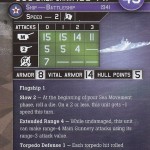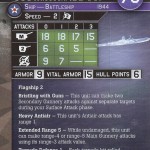 Wizards has released an official FAQ for Task Force, which is the new War at Sea release. The game became available for sale this past Friday and prompted lots of discussion regarding hopeful misprints.
Wizards has released an official FAQ for Task Force, which is the new War at Sea release. The game became available for sale this past Friday and prompted lots of discussion regarding hopeful misprints.
Thankfully Wizards heard the dissent and answered the questions in their document. We’ve turned their FAQ into a proper pdf file so you can download, print, and use it at your leisure. This is a document that will be quite helpful to have at hand. Not everyone checks online for updates and there’s a good chance that at least one member of your gaming group still believes the U-66 has speed 2.
While we could say go to War at Sea Task Force FAQ and read the pdf (you need the FREE Adobe Acrobat Reader) that wouldn’t be much of a blog article. I know you, the reader, come here for more than my sparkling personality and superior gaming intellect. Yes, I am jesting. But seriously you enjoy, at least I pretend you do, my analysis and thoughts on the gaming issues at hand.
Some of the entries I knew about last week, say Thursday (after I opened several of my cases) or Friday but most people did not. Richard Baker, lead game designer for War at Sea, announced a few of them on the official, read horrendous, Gleemax WoTC forum. Most, however, of the entries are new.
I strongly believe that several of the entries are unnecessary expenditures of time and energy on WotC’s end. For example of course the Jean Bart, the bane of my existence, only has one turret. If it was supposed to have more than one then everyone who pulled one, or in my case many, would have more turrets. At bare minimum we’d be able to compare with other gamers and see that our Jean Bart was the only one with a single turret.
The question relating to the SM.79 is yet another space waster. The Advanced Rules book specifically states that patrol bombers cannot base on a carrier. More exactly it says that “carriers can only base Fighters, Dive Bombers, and Torpedo Bombers (p. 31 Advanced Rules book).
Luckily most of the questions are very good and the answers very helpful. In particular the two dealing with smoke screens provide an answer to many questions. I’ve been entrenched in a debate on the very issue all weekend long and at last the answer is at our fingertips. Wizards has backpedaled and said that the rules for the Lay Smoke Screen SA from Set 1 is the way to handle it.
Other entries are helpful, and in my opinion should have been addressed before the release, but the star goes to solving the smoke screen confusion.





